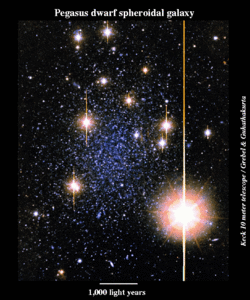Right ascension 23 51 46.3 Redshift −354 ± 3 km/s Apparent size (V) 4′.0 × 2′.0 | Declination +24° 34′ 57″ Type dSph Magnitude 14.2 Apparent magnitude (V) 14.2 | |
 | ||
Distance 2.7 ± 0.1 Mly (820 ± 20 kpc) Similar Cassiopeia Dwarf, Andromeda VIII, Pisces Dwarf, NGC 147, Cetus Dwarf | ||
The Pegasus Dwarf Spheroidal (also known as Andromeda VI or Peg dSph for short) is a dwarf spheroidal galaxy about 2.7 million light-years away in the constellation Pegasus. The Pegasus Dwarf is a member of the Local Group and a satellite galaxy of the Andromeda Galaxy (M31).
General information
The Pegasus Dwarf Spheroidal is a galaxy with mainly metal-poor stellar populations. Its metallicity is [Fe/H] ≃ −1.3. It is located at the right ascension 23h51m46.30s and declination +24d34m57.0s in the equatorial coordinate system (epoch J2000.0), and in a distance of 820 ± 20 kpc from Earth and a distance of 294 ± 8 kpc from the Andromeda Galaxy.
The galaxy was discovered in 1999 by various authors on the Second Palomar Observatory Sky Survey (POSS II) films.
References
Pegasus Dwarf Spheroidal Galaxy Wikipedia(Text) CC BY-SA
